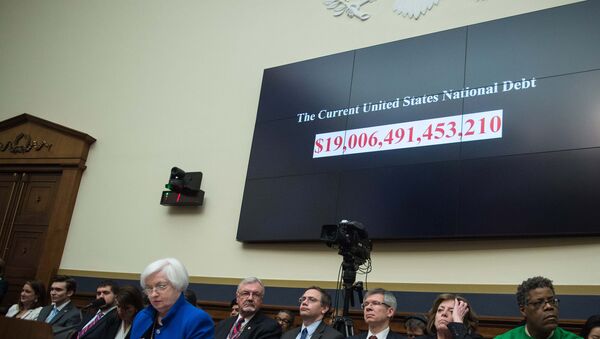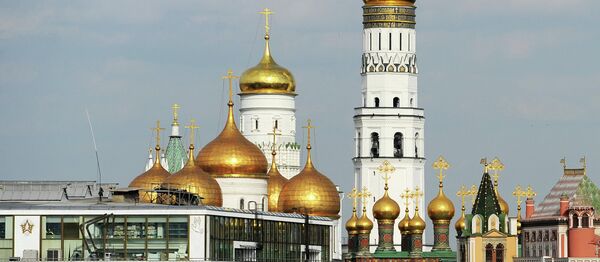Late last month, in addition to the growing debt, new data released by the Bureau of Economic Analysis showed that officials had been forced to downgrade economic growth in the second quarter of 2016 from 2.6% down to 1.2%.
Meanwhile, the Russian Ministry of Economic Development has drawn up its own balance sheet for the first half of the 2016. According to its statistics, the country's national debt has actually declined by 319.17 billion rubles, which amounts to about $4.86 billion US or about 2.9% of Russia's total national debt.
"It can be said without any irony that only a little, 10.63 trillion rubles [about $161 billion US] is left to be paid back," Psekezin wrote. "This is much less than the astronomical national debt of the United States, which in the end of January 2016 exceeded $19 trillion."
"In other words," Psekezin noted, "the real debt is nearly five times as high as the official one. But even the official amount [of $19 trillion] testifies to the fact that the United States has found itself in an astonishingly deep pit of debt."
"And if anyone is left unimpressed by these figures, others can be listed. They give as an idea of the percentage of GDP comprised by national debt. In this respect too, the forecast for the end of the year debt-to-GDP ratio is in Russia's favor, comprising 8.12%, vs. 115.394% for the US. Simply put, for us to pay off all our debts to creditors, we would have to knock off about one twelfth of our gross domestic product. The US, meanwhile, would have to lay out its entire GDP, and then find another 15%+ from somewhere."
Earlier this year, in his year-end report on the work of the Russian government for 2015, Prime Minister Dmitri Medvedev noted that as far as debt was concerned, the government has been left satisfied.
"We have managed to keep the national debt at a fairly low level. Speaking frankly, it's not just 'fairly low'; it's very low if we compare to other countries. This, by the way, is our competitive advantage; it is highlighted as such by all financial analysts and all international financial institutions," Medvedev said.
Unfortunately, Psekezin noted, while the "latest financial trick" by the US government may have "saved the country from technical default, it has also forced Americans to make unhappy conclusions about the gigantic size of their country's national debt."
"For example," the journalist noted, "Americans know that if the US were to print these money into hundred dollar bills and put them in one pile, the thickness of the stack would exceed the diameter of planet earth. And if the debt were distributed equally among all US citizens, everyone, including infants and the elderly would have to pay $53,000. If the debt burden was placed only on taxpayers, it would exceed $148,000 per person."
"And it's unlikely that Americans will be happy for their children or grandchildren. According to an IMF forecast, reflected in the report 'An Analysis of US Fiscal and Generational Imbalances: Who Will Pay and How?', by 2050 the US national debt will reach 400% of GDP. By the way, in 1980 the US national debt was less than one trillion dollars."
"Meanwhile," the Russian journalist noted, "the reverse trend is seen in Russia. Consider for example Russia's foreign debt. In January 2016, Russia's total foreign external debt amounted to $515 billion US. At the same time, the debt from the state and related agencies accounted for $270 billion of this amount, slightly half than the total amount, with $248 billion in private debt. And fluctuations to these figures over the last five years have not been critical."
"What does this speak of?" the journalist asked. "First, it speaks of our ability to learn from our own mistakes. In 1998, Russia its national debt peak, which amounted to 146.4% of GDP. But by 2007, the external debt was reduced to $52 billion, amounting to 5% of GDP."
"Secondly," Psekezin noted, "it speaks of our desire to live within our means. Third, it speaks of the desire to maintain a reputation of a solvent and responsible power."
"Another of their arguments is tied to primitive blackmail. The argument goes that many countries, such as China and Japan, have bought so much US government bonds that if they asked to be repaid, they would collapse not only the US economy, but their own as well. 'If you want a global collapse, go ahead', liberals scoff. But no matter how clever they may be in expressing their thoughts, the essence of their argument is the same: if you are strong, you have the liberty of doing everything you want, at the expense of everyone else."
"This is very miserable logic," Psekezin suggested. Unfortunately, "it corresponds quite well to the American doctrine of a unipolar world."





